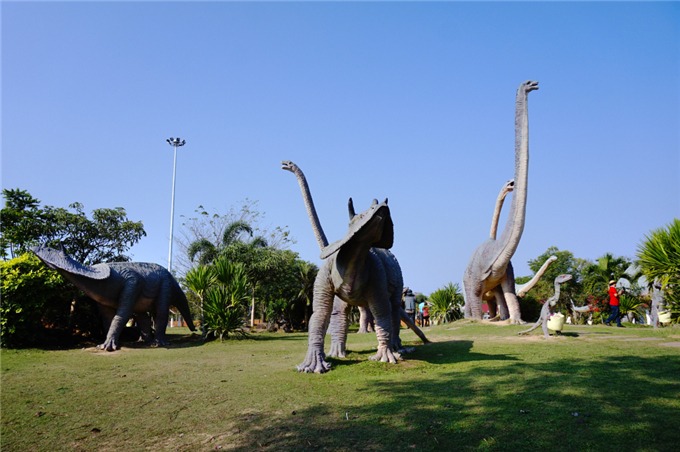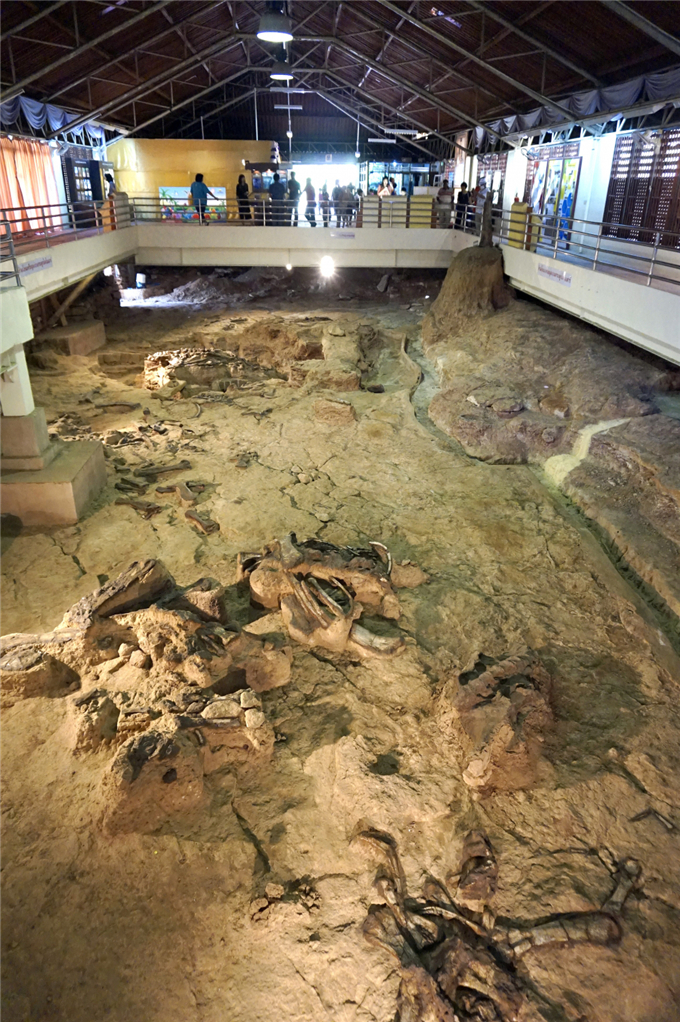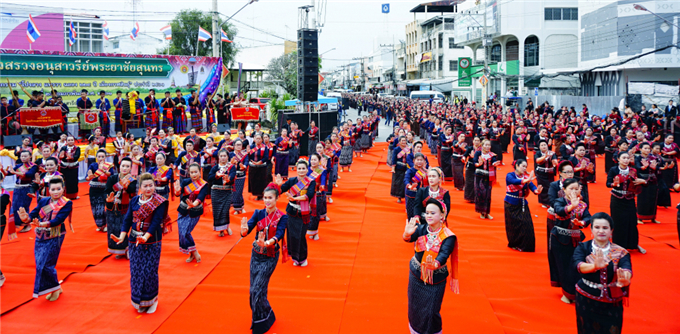Dinosaur bones of Kalasin in Thailand
In Thailand's dinosaur country, the scientists arrive with spades and the tourists with cameras
NORTHEASTERN Kalasin's remoteness and its place on the government’s Human Achievement Index among Thailand’s five poorest provinces tend to mask the facts that it’s blanketed with green rice and vegetable plantations (thanks to the Lam Pao Dam built in the 1960s) and boasts a long and remarkable history.

Kalasin Dinosaur Park is the traveller’s gateway to the Jurassic world
Billing itself as the cradle of Isaan culture, Kalasin was settled by the Lawa tribe 1,600 years ago. Millions of years before that, though, dinosaurs roamed the arid Isaan plateau – more there than anywhere else in present-day Thailand.
The bones dug up in Kalasin since 1978 have ensured a steady stream of both professional and amateur palaeontologists and geologists, who have collectively opened a window on the Kingdom’s own Jurassic world.
The dinosaurs come to life – almost – at Kalasin Dinosaur Park, an hour’s drive from the provincial capital, in Sahatsakhan district. Tourists and locals roam the mock prehistoric jungle, getting their pictures taken with lifelike, full-size replicas of Tyrannosaurus Rex and Apatosaurus.
Real-life palaeontologists are at work in the Sirindhorn Museum, a research centre that opened in 2008 and is run by the Department of Mineral Resources. Visitors are welcome to gawk at a huge variety of fossils.

Sirindhorn Museum is the place to see the wonderful array of dinosaur fossils that have been unearthed in Thailand since the first bones were found 1978
Exhibits, interactive educational games and replica skeletons are spread over two floors. The first gallery examines the origins of the universe and the Earth in the Big Bang. The second dives into the origin of life in the terrestrial oceans and follows its migration onto land.
The third zone arrives in the Palaeozoic Era, by the end of which complex reptiles were already munching on the first modern plants. Then we discover Pangaea, the super-continent that gradually broke apart with the motion of tectonic plates in the Earth’s crust, triggering mass extinction but paving the way for the emergence of the dinosaurs and, much later, the earliest mammals.
There are nine types of dinosaur fossils in the fifth room, all unearthed in the Thai Northeast.
Phuwiangosaurus sirindhornae, the first sauropod found in Thailand, was famously named after Her Royal Highness Princess Maha Chakri Sirindhorn, a keen student of palaeontology. Isanosaurus attavipatchi is the oldest sauropod found here and was named for the region, Isaan. Its bones are estimated to be 209 million years old.

Sirindhorn Museum is the place to see the wonderful array of dinosaur fossils that have been unearthed in Thailand since the first bones were found 1978
Psittacosaurus sattayaraki was the first Ceratopsian dinosaur found – from a family of giant reptiles with parrot-like beaks. There is the plant-eating Hypsilophodon, and Siamtyrannus isanensis –a cousin of T Rex whose discovery caused global ripples.
Ginnareemimus, the first “ostrich dinosaur”, was dug up in Khon Kaen. Albertosaurus gets its name from Alberta in Canada, but the specimen here came from Montana in the United States.
Siamosaurus suteethorni was the basis for Thailand’s prominence in world palaeontology, the first to be unearthed – and only its teeth at that.
Phu Kum Khao, the original site where fossils were found, is examined in the sixth section. Visitors can see the region’s biggest laboratory and many more dinosaur fossils as they learn about the process of excavating and identifying specimens.
Then it’s on to the mammals of the Cenozoic Era, 65 million years ago, whose lineage is traced down to the modern elephant, horse, rhinoceros, whale and bat.

The Phu Kum Khao sig site is where more than 700 bones from seven different specimens of Phuwiangosaurus sirindhornae turned up
Finally we see our own direct ancestors, follow our evolution from primeval times – and confront the geo-hazards we face to this day, such as landslides, volcanic eruptions and earthquakes. The aim here is to raise awareness about environmental conservation.
“Our team is studying plant-eating dinosaurs at the Phu Noi site in Kalasin,” researcher Sasidhorn Khansubha tells wide-eyed visitors. “We’ve discovered the bones of fish, turtles and crocodiles from 150 million years ago – more than 2,000 fossils so far.
“We’ve also found more than 200 footprints of dinosaurs, ancient ostriches and crocodiles and other small, plant-eating animals in Nakhon Phanom’s Tha Uthen district, which the public can see at the Dinosaur Footprint Park.”
The Phu Kum Khao excavation site is in Wat Sakkawan, adjacent to the museum. This is where the temple’s abbot, Phra Yanwisala Thera, discovered Thailand’s first dinosaur bones, in 1978. He knew they were not buffalo or elephant relics.
A French palaeontologist and geologists from the Department of Mineral Resources began digging in 1994. Since then, more than 700 bones from seven different specimens of Phuwiangosaurus have been unearthed – making the site more productive than any other in Southeast Asia.

In Phu Faek Forest Park are the footprints of carnivorous dinosaurs, preserved on a rocky escarpment
We wanted to see the great beasts’ footprints, so it was off to Phu Faek Forest Park in Huai Phueng district. Within these lush woods, a local family noticed the strange tracks along a rock terrace. Researchers have since 1996 identified 21 prints belonging to carnivorous dinosaurs – likely stomping through mud 140 million years ago – although now only seven footprints can be seen clearly.
Dinosaur hunting works up an appetite, so we headed downtown to the Ricemill Market, so named because it used to be one. Architect Worapong Boonsawat spent Bt15 million transforming his family’s mill and warehouse into a place where people can socialise, shop and dine. It dates all the way back to 2014.
“My family decided to close the mill after 45 years’ operation,” he says. “I turned it into a market to preserve the local history and give younger people a new place to hang out.”
The second phase, opening later this year, will feature a museum filled with antiques that will tell the story of local Thai-Chinese culture and rice mills.

The dinosaur-shaped roti at the Ricemill Market
The eight-rai market has more than 50 food-stalls, cafes and restaurants. You can get pretty much anything you want, from Isaan hotpot to Italian pizza, but no visitors is going to skip past the dinosaur-shaped roti.
The next morning, the Pong Lang Phrae Wa Festival was underway, marking the town’s 224th anniversary. They had 2,224 women dressed in lovely costumes of phrae wa silk perform a traditional Phu Thai dance in honour of the province’s first governor, Phraya Chaisoonthorn.
“Residents believe the festival brings good lives and happiness,” says the current governor, Kraisorn Kongchalad. “The performers come from all parts of Kalasin in their costumes, which promotes beautiful phrae wa silk as well as Phu Thai culture.
“Meanwhile we’re also promoting Kalasin as a city of art, though the focus is on the art of living rather than creating artwork. Kalasin is famous for its unique phrae wa silk and is the country’s second-biggest supplier of giant freshwater prawns. Any visitors interested in silk weaving can book home-stays at Baan Khok Pong.”

This year’s Pong Lang Phrae Wa Festival had 2,224 women dancers wearing Kalasin’s highly regarded phrae wa silk, paying homage at a monument to the first governor, Phraya Chaisoonthorn
Back out in Sahatsakhan district is Wat Phutthanimit, built in 1997 with a proud mix of Thai and Lanna architecture. The magnificent ubosot is all hardwood, with beautifully carved windows and ceiling panels depicting the lives of the Lord Buddha.
The main hall, the Wihan Sangkhanimit, is decorated with rare Buddha images and amulets and has a revered, two-metre-long Buddha statue reclining on the left side.
A square dominated by four towering Buddha statues is scheduled to be unveiled in April, built with durable laterite stone from Surin as a showcase for Thai and Khmer craftsmanship.
Editor: John Li